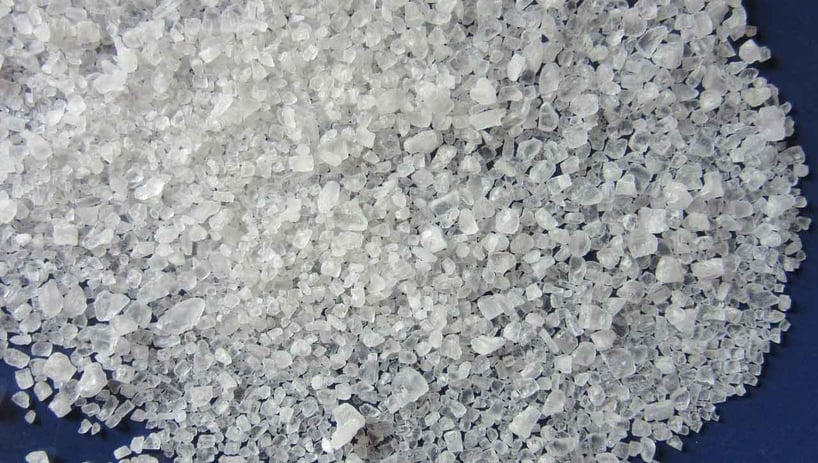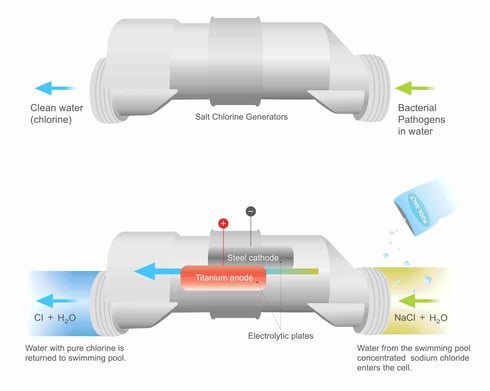14 Things You Must Know About Saltwater Pool Maintenance
September 15th, 2021
6 min read
By Jason Hughes

Salt systems are all the rage in the swimming pool world, and it's clear to see why:
- The water is softer
- Salt pools are often easier to maintain
- They don't irritate skin and eyes like traditional chlorine
And the list goes on.
But before you run out and switch to a salt system or set up your new pool as a saltwater pool, we want to make you aware of a few points about saltwater pool maintenance.
As fiberglass pool manufacturers who do installations for customers surrounding the River Pools headquarters, we get many salt system requests from new pool owners.
While we have our own sanitizing system that we typically recommend (better than saltwater in our experience), a salt-chlorine generator is an extremely popular choice and is growing in popularity each year.
So, if you've got your heart set on a saltwater pool, keep reading.
In this article, we're going to be transparent about the things you need to know before getting a saltwater pool and offer some pro tips at the end based on our many years of working with salt systems.

Keep a close eye on your chlorine levels
If you have a saltwater pool, you'll need to test the free-chlorine levels and pH at least once per week and add salt as needed. You might be tempted to skip this task every now and then, but we urge you to stay on top of it.
In a salt pool, you won't be able to smell the chlorine like you can in a traditional chlorine pool. If you remember anything, remember this: not smelling chlorine does not mean that the pool isn't over-chlorinated. You may not even notice if the chlorine level is ten times higher than it should be.
We've heard it before - pool owners think they need to add more salt when what they really need is to dial back the chlorination. Imagine their shock when they finally test the water and see what they've been swimming in.
Not only is over chlorination not good for your health, but it's also bad for your pool. If you want to keep your pool in good condition, make sure that you keep your chemicals balanced. And the only way to really know if your chlorine levels fall within a normal range is to test the water.
Pro tip: Set up alerts on your phone to remind you to do your pool chores.
Watch your pool deck
Salt is naturally corrosive, and it can wear down your concrete or paver patio. If there is a continual splashing of salt water onto the deck, it can take its toll over time. To keep the salt where it belongs, you can spray down your deck with a water hose about once per week. Salt is also corrosive to wood and stone pool decks, so be careful when pouring in your salt as well.
Read more: What Are the Best Materials for a Pool Patio?
Take care of your salt cell
The salt cell is the part that adds electricity to the saltwater to create chlorine. To keep your salt cell running smoothly, you'll need to examine it for buildup and debris every 30 to 90 days.

To inspect your salt cell, turn the power off, unplug the system, and unscrew the cell from the piping. You can look inside it to see if there is any debris or mineral buildup. Usually, this can be easily washed away with a power hose or manually scraped off using a wood tool.
If that doesn't work, you might need to wash it out with a muriatic acid solution (read about how to do that here). Muriatic acid is dangerous to handle, so don't hesitate to hire a professional to clean your salt cell if you feel uncomfortable.
Manually test your salt levels
It's extra work, but it's got to be done. Sure, there's a little digital reader that can tell you instantly what the salt levels in your pool are, but it can be wrong. To make sure your pool chemistry is on track, test your salt levels manually about once per month.
Take care of your pool tools
Metal skimmer handles and telescoping poles can wear down faster due to regular contact with saltwater. Be sure to keep an eye on them and wipe them down after each use if you want to extend their lifespan.
Read more: Which Pool Supplies Do You Need When You Buy a Pool?
Not all salt is made equal
Higher quality salt tends to be more expensive, while lower quality salt is cheaper. It can be tempting to save money by choosing the cheaper option, but the purity of your salt can impact the longevity of your salt system. Mined salt is the purest salt, and it's our number one recommendation.
Pro tip: No matter which salt you choose for your pool, be sure that it's made for pools, food-grade, granular, and non-iodized.
Read more: Salt Water Pools: What Type of Salt Should I Use and Why?
You need good circulation
If your pool does not circulate your water properly, a salt system won't be as effective (circulation is the movement of water in the swimming pool). The saltwater concentrations might also damage your pool if you have poorly circulated pockets.
How will you know if your pool has bad circulation?
The first telltale sign of bad circulation in a pool is algae repeatedly collecting in certain areas. If you've tested these areas, you might also notice lower levels of pool sanitizer.
To see if your pool is set up with an adequate circulation system, you can have a specialist perform a dye test, or you can use a salt concentration detector to measure the salt levels across the different zones of your pool.
If your pool is poorly circulating the water, you may need to have the jets adjusted or reconfigure other parts of the system.
Saltwater can burn your grass
If you want to have a patch of grass or plants immediately to one side of your pool, you'll need to be extra careful with splashing water. Another important rule to remember is never dump your pool water into your plants or lawn.
Replace parts as needed
No matter how well you maintain your pool, certain parts of your salt system will need to be replaced. Specifically, your salt cell and control board will each probably need to be replaced every 3 to 7 years.
Read more: Inground Saltwater Pool Cost: Salt, Cells, Generators, and More
Check your handrails
Metal handrails and ladders are at risk of wearing out quicker due to continuous contact with saltwater. Your biggest issue will likely be with the anchors and not with the metal rail itself. One easy fix is to swap out your existing anchors with brass ones.
Read more: Saltwater Pools FAQ
Test your water chemistry at least weekly
Like any pool, you'll need to test all of the chemical levels in your water at least once per week (in addition to weekly pH and free chlorine testing). Make sure to test your pool's alkalinity, calcium, and stabilizer (likely CYA), and don't forget about manual salt testing. Keeping these chemicals balanced is crucial to the overall maintenance of your salt pool.
Read more: The Basics of Testing Your Inground Pool's Water Chemistry
Watch your pool plaster
If your concrete or gunite pool has a plaster surface, make sure that salt isn't collecting in one area. This can wear down the plaster over time and even cause stains. If your pool is covered in aggregate, you might also want to keep an eye out for collecting salt.
Read more: Are Salt Water Systems Bad for Concrete Pools?
Inspect metal pool walls
When you do your liner replacements every few years, be sure to inspect the walls for signs of rust and corrosion. While the saltwater doesn't typically come into direct contact with your pool's structure, it can seep behind the vinyl liner and eat away at the metal. If you see that your metal vinyl liner pool wall is rusty or corroded, you can temporarily repair it with a piece of sheet metal. You can also apply pool wall foam to try to keep the rust at bay.
Pro tip: The best vinyl pool option for salt systems is polymer walls.
Take care of your automatic pool cover
We often say it's a good idea not to mix automatic covers with salt pools (salt corrodes the metal parts), but it doesn't mean you can't. If you have an automatic cover on your saltwater pool, you can prevent premature corrosion by rinsing the metal track with a garden hose from time to time. You might also want to get in the habit of inspecting your metal pool cover parts to stay on top of repairs and replacements.
Note: Many of these points should not be an issue if you are using a brine system. In a brine salt chlorinator, the salt is added to a tank where the chlorine is generated before entering the pool.
Salt Pool Maintenance Tips
Before you go, here are our top saltwater swimming pool maintenance tips to keep in mind:
- Resist the urge to add more salt for "good measure". Add just enough, and test your free chlorine levels regularly to make sure you haven't gone overboard.
- Don't assume that if you can't smell the chlorine, it's not too high. Again, stay on top of your testing. We suggest setting up alerts on your phone or calendar.
- Even a salt water pool requires the occasional pool shock. Make sure you follow any instructions from your pool builder, salt cell manufacturer, and pool shock maker to properly treat the water in your saltwater pool.
- If you feel uncomfortable handling acid for your salt cell, hire a professional to do it for you.
- Regularly spray down your pool deck and the area above your waterline to keep salt corrosion at bay.
- Choose a salt with fewer impurities to get the most life out of your generator.
- Manually test the salt levels in your pool to make sure your system is on track.
In the end, a salt pool requires less hands-on maintenance than a chlorine pool, and it costs about the same. But in order to keep your pool running smoothly, make sure to stay on top of your maintenance routine. If you have questions, you can leave them for us in the comments, and we'll get back to you as soon as possible.
At River Pools, we manufacture world-class fiberglass pools for customers across North America. Fiberglass swimming pools are highly compatible with salt systems, arguably the most compatible inground pool type. If you'd like to explore your fiberglass pool options, you can browse our pool models, request custom pricing, or try out our pool cost calculator below for an instant quote!

Want to see about how much that cost will be with all your favorite pool accessories?
Use our Design and Price Tool to walk through your options and approximate price!
Up Next:
The Best Low Maintenance Pool, Landscaping, and Outdoor Living Space Ideas
Jason Hughes is a partner at River Pools Virginia, a fiberglass pool installation company based in Warsaw, Virginia. With over 20 years of hands-on experience, Jason has dedicated his career to helping families create beautiful, functional backyards while ensuring every fiberglass pool installation meets the highest standards of quality and safety. In addition to his work with homeowners, Jason serves as a GENESIS instructor with the Pool & Hot Tub Alliance (PHTA), where he teaches fiberglass pool installation best practices to pool professionals across the country. Whether he’s on a job site or leading a training session, Jason is passionate about raising the bar for fiberglass pool installations and helping families make confident, informed decisions as they transform their outdoor spaces.
Topics:


